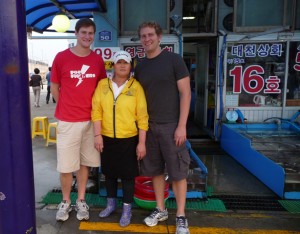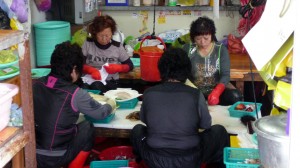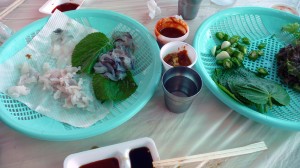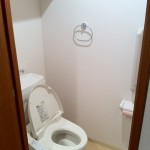This is what I love about travel.
My brother and I were in the sleepy port town of Sokcho, South Korea, and we heard loud voices coming from this building:

Naturally we wanted to see what the commotion was about, and as we approached, we saw booth after booth of women selling live sea creatures.

We noted the sight and continued on our way. As we walked around, we noticed that people seemed to be carrying baskets of food to the top floor of this building. Intriguing. As usual, we followed the crowd to the top floor and we found hundreds of people eating soup and fresh seafood. We figured, people mush be buying the sea creatures below, bringing them up here, and eating! Only if. Only if we could do that, how cool. We discussed it, there seemed to be too many hurdles. Figuring out what to eat, negotiating a price, somehow cleaning the fish (that was a big one), conveying to the people on the top floor of the building we wanted to eat what we brought, it seemed daunting. We did one more loop around the building, trying to figure out how we might pull this off… there was no obvious solution to us. It just seemed to complicated. As we were walking away, a woman yelled out. “Hello! Hello!” We turned around, “You eat?” she asked. This woman became our savior.

“How much?” The first question in most travel situations. The woman grabbed a basket and dunked her hand into the tanks. She pulled out four live shrimp, two squid, and about four other fish I can’t begin to describe.

“Twenty.” She said. “Twenty thousand?” I wrote on my hand, a two followed by four zeros. She nodded yes… quick converstion calculation… about $18. Deal! We asked, “How do we cut?” We mimed cutting the fish, she understood. She beckoned us to the back of the store, revealing her worker bees.

These women cut and clean sea creatures all day (I keep saying sea creatures, because fish is just too limiting). Perfect! The woman handed us a menu, we looked at it… ok, ok. These must be the topping/side dishes. Perfect! We’ll take it. We motioned to her… “Can you take us upstairs?” We pointed up. She nodded. Of course she’ll help these tall helpless white giants. So, the worker bees cleaned the creatures, placing the parts onto a nice basket, the woman handed us our sides and she led us upstairs. We sat down at a table, a waitress brought us water, but we noticed that other tables had soup and rice, we want that too. We ordered by pointing (the norm). Everyone nodded, ok, ok. Things are working out. We stared at the basket of fish parts (picture below). The picture is tough to see, but in the left basket, the there are white fish parts and dark squid parts. We ate the shrimp before I took the picture. Oops! The right basket are the garnishes.

The next dilemma .. I tried to ask, “Do we eat raw? Or wait for soup?” I couldn’t get this question across via mime. At this point we were testing the woman’s patience. She sighed and motioned for us to eat. I picked up a shrimp, head and all, hmmmm. The woman grabbed the shrimp from me, broke off the head and handed the body, legs, tail and all, back to me. She motioned to eat. I ate it. It was crunchy. She did the same for my brother. OK. Raw it is! We smiled, nodded, gave her a thumbs up, and she nodded walked away. We dug in! The fish head soup came, we alternated eating the fish raw and dipping it in boiling water. What a great meal.

After eating all the “good parts” that we bought downstairs, I ventured to eat the fish heads in the soup. The fish heads were not bad. It’s just that they had 1 trillion little bones inside and were about 20% skin:

Like I said, not bad, just exhausting to eat! No wonder Asians are so skinny. It’s exhausting to eat. We finished up the soup, drank the broth and nodded. That was really good and it worked out perfectly. We got up, paid and left. These are the experiences I love.
Then we got hamburgers, we were still hungry!









